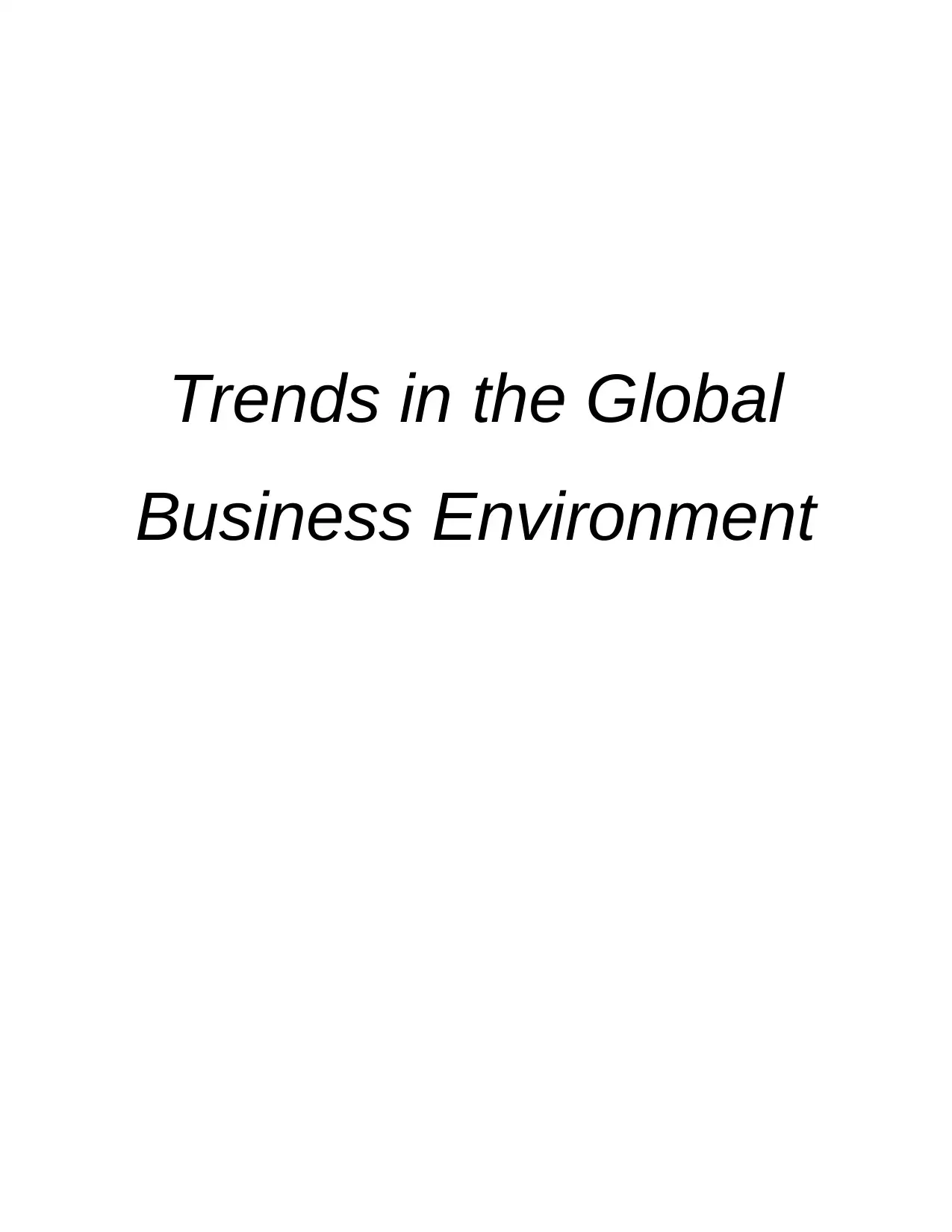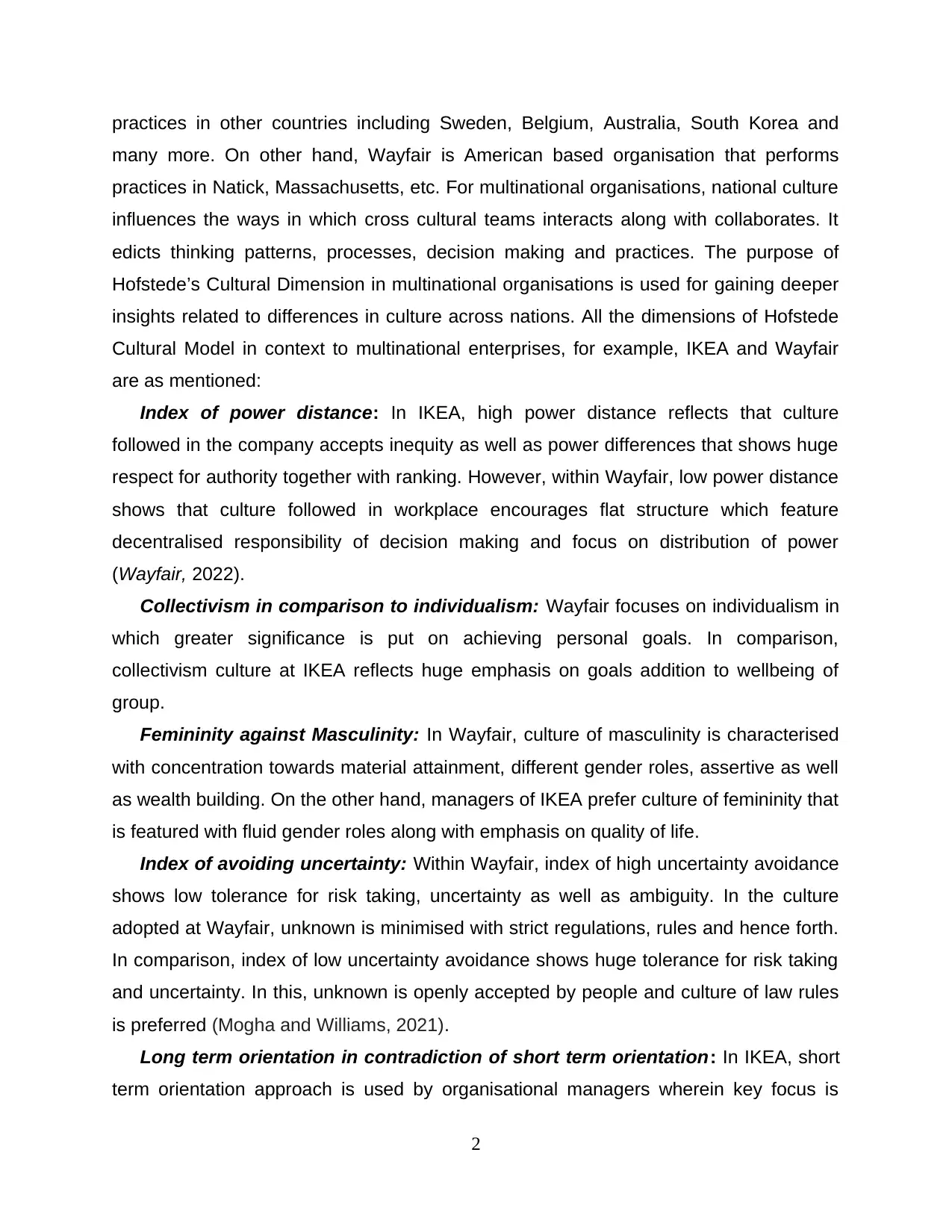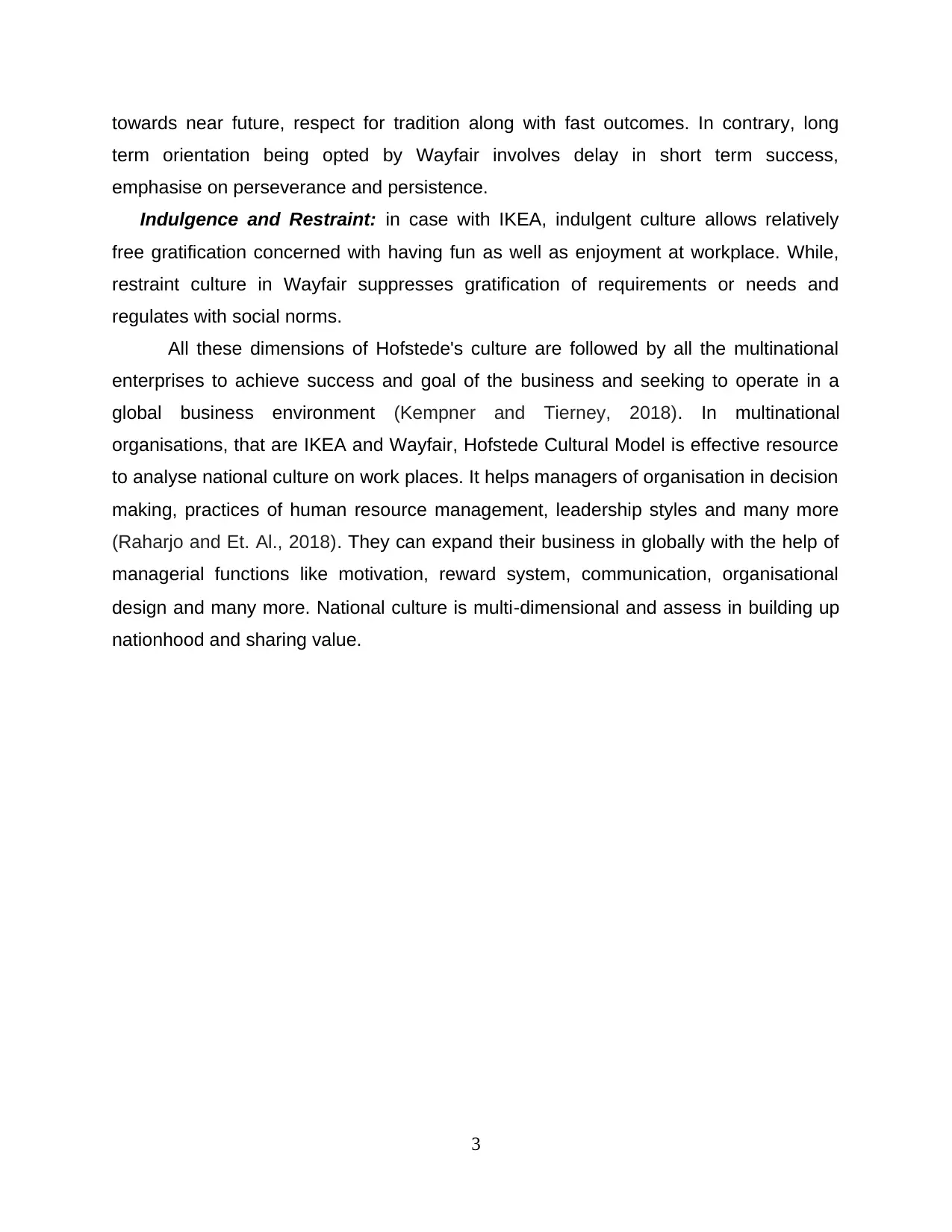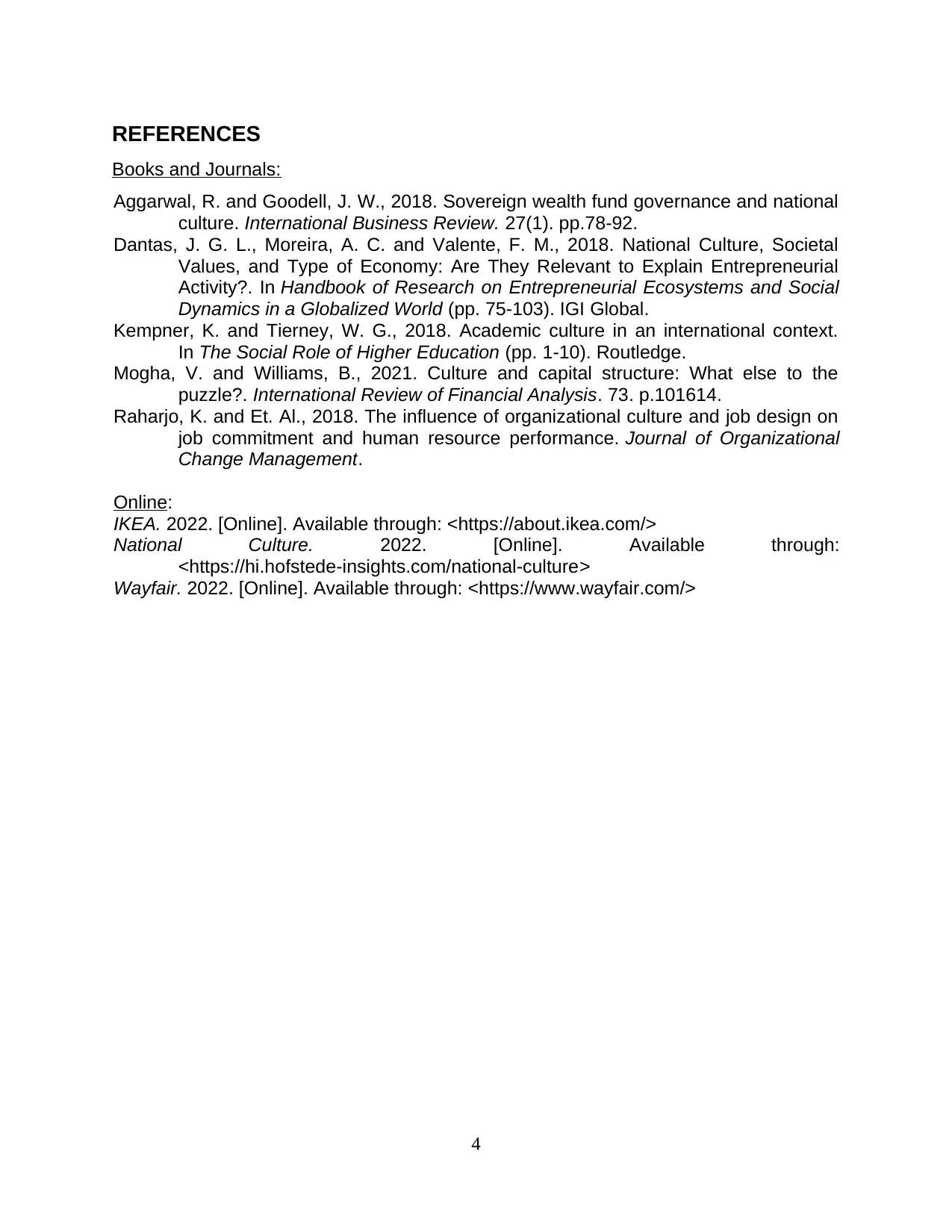Multinational Enterprises: IKEA, Wayfair & National Culture Adaptation
VerifiedAdded on 2023/06/05
|6
|1293
|489
Essay
AI Summary
This essay examines how multinational enterprises, specifically IKEA and Wayfair, adapt to national cultures in the global business environment. It emphasizes the importance of understanding national culture, defined as a society's collective mental programming, and its implications for business management and human resource development. The essay uses Hofstede's cultural dimensions as a framework to analyze the cultural differences and adaptation strategies employed by IKEA and Wayfair, highlighting variations in power distance, individualism vs. collectivism, masculinity vs. femininity, uncertainty avoidance, and long-term orientation. It concludes that Hofstede's Cultural Model is a valuable resource for multinational organizations to analyze national culture in the workplace, aiding in decision-making, human resource management, and leadership styles, ultimately contributing to their global success. Desklib provides access to similar solved assignments and study tools for students.

Trends in the Global
Business Environment
Business Environment
Paraphrase This Document
Need a fresh take? Get an instant paraphrase of this document with our AI Paraphraser

Contents
Contents.........................................................................................................................................2
MAIN BODY...................................................................................................................................1
6. National Culture adaptation by multinational enterprises that are IKEA and Wayfair
to operate in international business environment................................................................1
REFERENCES..............................................................................................................................4
Contents.........................................................................................................................................2
MAIN BODY...................................................................................................................................1
6. National Culture adaptation by multinational enterprises that are IKEA and Wayfair
to operate in international business environment................................................................1
REFERENCES..............................................................................................................................4

MAIN BODY
6. National Culture adaptation by multinational enterprises that are IKEA and Wayfair to
operate in international business environment
National culture is said to society's collective mental programming and its nature
gave important implications for the company, its human resource development and
business management in the prevailing environmental and local context (Aggarwal and
Goodell, 2018). For IKEA, national culture influences leadership styles, practices for
managing human resources and managerial leadership styles. Culture has numerous
definitions, but inside the simplest phrases, tradition refers to the norms, ideals, ideas,
attitudes, and social conduct of an individual or society. In a manner, subculture is the
coming together of different experiences, values, beliefs, and ideas that have an effect
on the conduct and attitude of a community, a selected man or woman, or a collection.
Some crucial cultural elements are faith, language, gender roles, social structure and
dynamics, traditions, legal guidelines, and customs. Cultural model in international
business encompasses organizational tradition in addition to national cultures and
traditions. It allows the agencies to have a better knowledge of how nearby
organizations and the body of workers feature. At same time, national culture also
impacts functions of management by highly influencing cognition along with behaviour
of people working at different workplaces. In the company, around 225,000 employees
work worldwide belonging to different cultural backgrounds, which bring unique skills,
experience and ideas with them (IKEA, 2022). It helps them to make extraordinary
outcomes happen for their buyers. For IKEA, national culture is important because they
aim for culture diversity of their top level or senior leaders as they have to match the
diversity of culture of the country’s population.
There are some dimensions which helps companies which are used by
managers of companies for understanding national culture (National Culture, 2022).
Hofstede's cultural dimensions in context to multinational enterprises are as outlines:
Hofstede's cultural dimensions is the framework used by the managers of
organisation to understand the differences in culture all over the world across countries
(Dantas, Moreira and Valente, 2018). IKEA is based in the Netherlands and operates
1
6. National Culture adaptation by multinational enterprises that are IKEA and Wayfair to
operate in international business environment
National culture is said to society's collective mental programming and its nature
gave important implications for the company, its human resource development and
business management in the prevailing environmental and local context (Aggarwal and
Goodell, 2018). For IKEA, national culture influences leadership styles, practices for
managing human resources and managerial leadership styles. Culture has numerous
definitions, but inside the simplest phrases, tradition refers to the norms, ideals, ideas,
attitudes, and social conduct of an individual or society. In a manner, subculture is the
coming together of different experiences, values, beliefs, and ideas that have an effect
on the conduct and attitude of a community, a selected man or woman, or a collection.
Some crucial cultural elements are faith, language, gender roles, social structure and
dynamics, traditions, legal guidelines, and customs. Cultural model in international
business encompasses organizational tradition in addition to national cultures and
traditions. It allows the agencies to have a better knowledge of how nearby
organizations and the body of workers feature. At same time, national culture also
impacts functions of management by highly influencing cognition along with behaviour
of people working at different workplaces. In the company, around 225,000 employees
work worldwide belonging to different cultural backgrounds, which bring unique skills,
experience and ideas with them (IKEA, 2022). It helps them to make extraordinary
outcomes happen for their buyers. For IKEA, national culture is important because they
aim for culture diversity of their top level or senior leaders as they have to match the
diversity of culture of the country’s population.
There are some dimensions which helps companies which are used by
managers of companies for understanding national culture (National Culture, 2022).
Hofstede's cultural dimensions in context to multinational enterprises are as outlines:
Hofstede's cultural dimensions is the framework used by the managers of
organisation to understand the differences in culture all over the world across countries
(Dantas, Moreira and Valente, 2018). IKEA is based in the Netherlands and operates
1
⊘ This is a preview!⊘
Do you want full access?
Subscribe today to unlock all pages.

Trusted by 1+ million students worldwide

practices in other countries including Sweden, Belgium, Australia, South Korea and
many more. On other hand, Wayfair is American based organisation that performs
practices in Natick, Massachusetts, etc. For multinational organisations, national culture
influences the ways in which cross cultural teams interacts along with collaborates. It
edicts thinking patterns, processes, decision making and practices. The purpose of
Hofstede’s Cultural Dimension in multinational organisations is used for gaining deeper
insights related to differences in culture across nations. All the dimensions of Hofstede
Cultural Model in context to multinational enterprises, for example, IKEA and Wayfair
are as mentioned:
Index of power distance: In IKEA, high power distance reflects that culture
followed in the company accepts inequity as well as power differences that shows huge
respect for authority together with ranking. However, within Wayfair, low power distance
shows that culture followed in workplace encourages flat structure which feature
decentralised responsibility of decision making and focus on distribution of power
(Wayfair, 2022).
Collectivism in comparison to individualism: Wayfair focuses on individualism in
which greater significance is put on achieving personal goals. In comparison,
collectivism culture at IKEA reflects huge emphasis on goals addition to wellbeing of
group.
Femininity against Masculinity: In Wayfair, culture of masculinity is characterised
with concentration towards material attainment, different gender roles, assertive as well
as wealth building. On the other hand, managers of IKEA prefer culture of femininity that
is featured with fluid gender roles along with emphasis on quality of life.
Index of avoiding uncertainty: Within Wayfair, index of high uncertainty avoidance
shows low tolerance for risk taking, uncertainty as well as ambiguity. In the culture
adopted at Wayfair, unknown is minimised with strict regulations, rules and hence forth.
In comparison, index of low uncertainty avoidance shows huge tolerance for risk taking
and uncertainty. In this, unknown is openly accepted by people and culture of law rules
is preferred (Mogha and Williams, 2021).
Long term orientation in contradiction of short term orientation: In IKEA, short
term orientation approach is used by organisational managers wherein key focus is
2
many more. On other hand, Wayfair is American based organisation that performs
practices in Natick, Massachusetts, etc. For multinational organisations, national culture
influences the ways in which cross cultural teams interacts along with collaborates. It
edicts thinking patterns, processes, decision making and practices. The purpose of
Hofstede’s Cultural Dimension in multinational organisations is used for gaining deeper
insights related to differences in culture across nations. All the dimensions of Hofstede
Cultural Model in context to multinational enterprises, for example, IKEA and Wayfair
are as mentioned:
Index of power distance: In IKEA, high power distance reflects that culture
followed in the company accepts inequity as well as power differences that shows huge
respect for authority together with ranking. However, within Wayfair, low power distance
shows that culture followed in workplace encourages flat structure which feature
decentralised responsibility of decision making and focus on distribution of power
(Wayfair, 2022).
Collectivism in comparison to individualism: Wayfair focuses on individualism in
which greater significance is put on achieving personal goals. In comparison,
collectivism culture at IKEA reflects huge emphasis on goals addition to wellbeing of
group.
Femininity against Masculinity: In Wayfair, culture of masculinity is characterised
with concentration towards material attainment, different gender roles, assertive as well
as wealth building. On the other hand, managers of IKEA prefer culture of femininity that
is featured with fluid gender roles along with emphasis on quality of life.
Index of avoiding uncertainty: Within Wayfair, index of high uncertainty avoidance
shows low tolerance for risk taking, uncertainty as well as ambiguity. In the culture
adopted at Wayfair, unknown is minimised with strict regulations, rules and hence forth.
In comparison, index of low uncertainty avoidance shows huge tolerance for risk taking
and uncertainty. In this, unknown is openly accepted by people and culture of law rules
is preferred (Mogha and Williams, 2021).
Long term orientation in contradiction of short term orientation: In IKEA, short
term orientation approach is used by organisational managers wherein key focus is
2
Paraphrase This Document
Need a fresh take? Get an instant paraphrase of this document with our AI Paraphraser

towards near future, respect for tradition along with fast outcomes. In contrary, long
term orientation being opted by Wayfair involves delay in short term success,
emphasise on perseverance and persistence.
Indulgence and Restraint: in case with IKEA, indulgent culture allows relatively
free gratification concerned with having fun as well as enjoyment at workplace. While,
restraint culture in Wayfair suppresses gratification of requirements or needs and
regulates with social norms.
All these dimensions of Hofstede's culture are followed by all the multinational
enterprises to achieve success and goal of the business and seeking to operate in a
global business environment (Kempner and Tierney, 2018). In multinational
organisations, that are IKEA and Wayfair, Hofstede Cultural Model is effective resource
to analyse national culture on work places. It helps managers of organisation in decision
making, practices of human resource management, leadership styles and many more
(Raharjo and Et. Al., 2018). They can expand their business in globally with the help of
managerial functions like motivation, reward system, communication, organisational
design and many more. National culture is multi‐dimensional and assess in building up
nationhood and sharing value.
3
term orientation being opted by Wayfair involves delay in short term success,
emphasise on perseverance and persistence.
Indulgence and Restraint: in case with IKEA, indulgent culture allows relatively
free gratification concerned with having fun as well as enjoyment at workplace. While,
restraint culture in Wayfair suppresses gratification of requirements or needs and
regulates with social norms.
All these dimensions of Hofstede's culture are followed by all the multinational
enterprises to achieve success and goal of the business and seeking to operate in a
global business environment (Kempner and Tierney, 2018). In multinational
organisations, that are IKEA and Wayfair, Hofstede Cultural Model is effective resource
to analyse national culture on work places. It helps managers of organisation in decision
making, practices of human resource management, leadership styles and many more
(Raharjo and Et. Al., 2018). They can expand their business in globally with the help of
managerial functions like motivation, reward system, communication, organisational
design and many more. National culture is multi‐dimensional and assess in building up
nationhood and sharing value.
3

REFERENCES
Books and Journals:
Aggarwal, R. and Goodell, J. W., 2018. Sovereign wealth fund governance and national
culture. International Business Review. 27(1). pp.78-92.
Dantas, J. G. L., Moreira, A. C. and Valente, F. M., 2018. National Culture, Societal
Values, and Type of Economy: Are They Relevant to Explain Entrepreneurial
Activity?. In Handbook of Research on Entrepreneurial Ecosystems and Social
Dynamics in a Globalized World (pp. 75-103). IGI Global.
Kempner, K. and Tierney, W. G., 2018. Academic culture in an international context.
In The Social Role of Higher Education (pp. 1-10). Routledge.
Mogha, V. and Williams, B., 2021. Culture and capital structure: What else to the
puzzle?. International Review of Financial Analysis. 73. p.101614.
Raharjo, K. and Et. Al., 2018. The influence of organizational culture and job design on
job commitment and human resource performance. Journal of Organizational
Change Management.
Online:
IKEA. 2022. [Online]. Available through: <https://about.ikea.com/>
National Culture. 2022. [Online]. Available through:
<https://hi.hofstede-insights.com/national-culture>
Wayfair. 2022. [Online]. Available through: <https://www.wayfair.com/>
4
Books and Journals:
Aggarwal, R. and Goodell, J. W., 2018. Sovereign wealth fund governance and national
culture. International Business Review. 27(1). pp.78-92.
Dantas, J. G. L., Moreira, A. C. and Valente, F. M., 2018. National Culture, Societal
Values, and Type of Economy: Are They Relevant to Explain Entrepreneurial
Activity?. In Handbook of Research on Entrepreneurial Ecosystems and Social
Dynamics in a Globalized World (pp. 75-103). IGI Global.
Kempner, K. and Tierney, W. G., 2018. Academic culture in an international context.
In The Social Role of Higher Education (pp. 1-10). Routledge.
Mogha, V. and Williams, B., 2021. Culture and capital structure: What else to the
puzzle?. International Review of Financial Analysis. 73. p.101614.
Raharjo, K. and Et. Al., 2018. The influence of organizational culture and job design on
job commitment and human resource performance. Journal of Organizational
Change Management.
Online:
IKEA. 2022. [Online]. Available through: <https://about.ikea.com/>
National Culture. 2022. [Online]. Available through:
<https://hi.hofstede-insights.com/national-culture>
Wayfair. 2022. [Online]. Available through: <https://www.wayfair.com/>
4
⊘ This is a preview!⊘
Do you want full access?
Subscribe today to unlock all pages.

Trusted by 1+ million students worldwide
1 out of 6
Related Documents
Your All-in-One AI-Powered Toolkit for Academic Success.
+13062052269
info@desklib.com
Available 24*7 on WhatsApp / Email
![[object Object]](/_next/static/media/star-bottom.7253800d.svg)
Unlock your academic potential
Copyright © 2020–2025 A2Z Services. All Rights Reserved. Developed and managed by ZUCOL.




